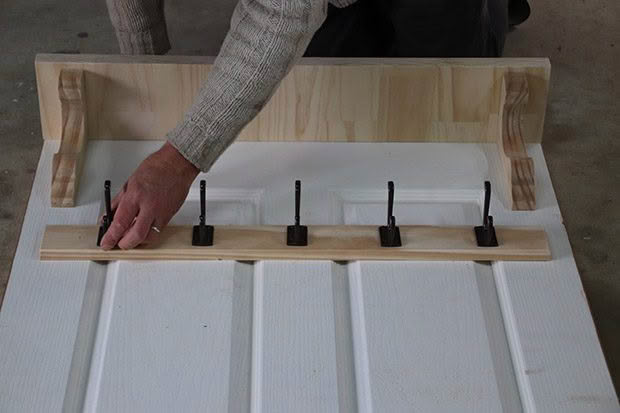DIY Project: Make a coat stand from an old door

Turn an old door into a stylish — and useful — piece of furniture.
Words & images Julie & Jel Legg
Every entrance needs somewhere to hang coats, tidy away shoes, or a place to sit when putting on or taking off shoes. This upcycling of an old door could also be extra storage space for a spare room or used to hang tools in a shed.
Before you begin, check the space you have available to make sure the finished stand will fit the space height, width, and depth-wise.
MATERIALS
1 x 30mm x 900mm x 2100mm laminated wood panel in a clear finish
2 x 1.2m 65mm x18mm radiata pine
assorted screws (65mm+)
2 x decorative pine fretworks
coat hooks
Resene Quick Dry waterborne primer undercoat
Resene Lustacryl semi-gloss waterborne enamel tinted to Resene Double Tea & Resene Alabaster
Resene Colorwood natural stain, tinted to Resene Deep Oak
INSTRUCTIONS
Step 1: Work out how high and how deep you want your bench seat. Cut the laminated panel into two equal pieces, which will become the solid upright sides. For our project, the sides were 600mm high.

Julie’s tip: Solid external doors work best, but we successfully used an old internal door. These are often hollow, so don’t overtighten screws as they may create an ugly indentation.
Step 2: Lay the door down on a flat surface. Position both upright sides on the door; the lower edges should be flush with the bottom of the door and the sides, or you could indent the sides for aesthetics. Measure and cut two equal lengths of pine to be the armrests. Sand the edges to remove burrs.
Step 3: Measure the distance between the two upright sides to determine the width of the seat and lower shelf. Cut the remaining laminated panel into two equal pieces; these will become the seat and the lower shelf.

Step 4: Place the wood for the seat and lower shelf in position. The lower shelf can be flush with the bottom of the door, or you may choose to have it slightly off the ground and cut a kickboard to size. For this project, we made the seat 430mm high and raised the lower shelf 100mm off the floor. Don’t fix in place until Step 8.

Step 5: Cut a piece of laminated panel to size to create a single upper shelf and position it and the fretwork in place, but don’t fix in place until Step 8.

Step 6: Cut a single slat of the remaining radiata for the coat rack base, but don’t fix in place until Step 8.

Step 7: Paint or stain all individual pieces, particularly inward-facing surfaces, before assembly. We used Resene Quick Dry primer undercoat, then finished it with 2-3 coats of topcoat. We used Resene Lustacryl semi-gloss waterborne enamel tinted to Resene Double Tea for the bench seat sides, upper shelf, fretwork, and coat rack, and tinted Resene Quarter Alabaster for the door. For contrast, we used Resene Colorwood natural wood stain interior tinted to Resene Deep Oak for the bench seat and lower shelf. Leave to dry.
Step 8: Square up, clamp, then screw together all the elements of the bench seat except for the armrests – don’t fix it to the door until Step 9. Fix together using screws on all three outward-facing sides. Fill screw holes in the outward-facing surfaces, sand, and paint.
Step 9: Attach the bench seat to the lower part of the door. Screw through the back of the door into the bench. Fix the armrests squarely in place with screws. Fill, sand, and touch up paint if required.
Step 10: Secure the upper shelf in place using screws going through the back of the door. Secure the fretwork in place using screws from above and behind. For the coat rack, use screws (for a solid-wood door) or a decorative bolt (for a hollow door). Position, then screw the coat hooks to your desired spacing.
Love this story? Subscribe now!
 This article first appeared in NZ Lifestyle Block Magazine.
This article first appeared in NZ Lifestyle Block Magazine.





